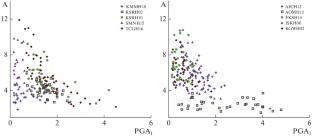Abstract—The response of sandy and clay subsurface soils, representing classes of non-cohesive and cohesive soils, during seismic motion of various intensities is analyzed based on the in situ observations—records by seismic vertical arrays of the Japanese strong motion network KiK-net. From a total of ~800 stations, five stations with sandy and five stations with clayey subsurface soils represented in the upper layers in their purest forms were selected for the analysis. For sandy and clayey stations, models of soil behavior during strong motion were constructed by the method of (Pavlenko and Irikura, 2003), showing vertical distributions of stresses and strains induced by strong motion in soil layers; and the behaviors were compared. Similar estimates of the amplification of seismic waves in sands and clays during weak motions and similar stress-strain relations describing the behavior of subsurface soils during moderate seismic motions are obtained. The liquefaction of sandy soils during strong motions (the 2011 Tohoku earthquake, Mw ~ 9.0) and the effects of extended seismic source (the directivity of seismic radiation) on the behavior of sandy and clayey soils and amplification of seismic waves are analyzed. Differences in the behavior of sandy and clayey soils are observed only during strong motions, namely, liquefaction occurs in sandy soils (when the groundwater level is about several meters from the surface), but never in clayey soils.



